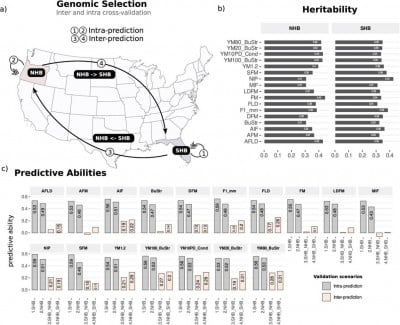As global consumption of blueberries continues to soar, driven by their antioxidant-rich “superfood” status, growers face rising pressure to deliver fruits that not only taste good but also hold up during storage and transport. Texture—how a berry feels when bitten—affects consumer appeal, shelf life, and postharvest performance. However, traditional methods for evaluating texture are labor-intensive and limited in scope. New tools now allow for quantifying multiple dimensions of fruit firmness, offering a more nuanced view. Due to these challenges, unlocking the genetic mechanisms underlying blueberry texture is essential for advancing breeding efforts aimed at quality and longevity.
In a collaborative effort published (DOI: 10.1093/hr/uhae233) on August 21, 2024, in Horticulture Research, researchers from the University of Florida, North Carolina State University, USDA-ARS, and international institutions unveiled new insights into the genetic foundation of blueberry texture. Analyzing 2,289 northern and southern highbush blueberry genotypes using advanced genotyping and texture profiling, the team aimed to identify critical traits and genetic markers. Their study not only mapped candidate genes but also evaluated how predictive genomic models could guide future blueberry breeding strategies.
The researchers assessed 17 texture-related traits—such as stiffness, puncture force, and burst strain—using a texture analyzer across large, diverse breeding populations. Their analysis revealed distinct textural profiles between northern and southern highbush blueberries, with mechanical parameters like YM20_BuStr and burst strain playing a key role in separating the two types.
Genome-wide association studies pinpointed over 100 genetic regions linked to texture, including hotspots on chromosomes 5 and 7. Several candidate genes were uncovered, many of which are known to influence cell wall composition and fruit softening, such as XTH, PME, and PEL. These findings suggest that blueberry texture, although genetically complex, is influenced by a network of genes that can now be targeted in breeding.
Heritability estimates ranged from low to moderate, reflecting a polygenic architecture. However, genomic prediction models showed moderate accuracy within populations, especially in southern highbush lines. These models demonstrated that selecting for texture traits based on DNA markers could streamline breeding decisions. The study also found that evaluating just 10 berries per genotype yielded reliable results, reinforcing the efficiency of the phenotyping strategy.
“Texture has always been a tough nut to crack in blueberry breeding—it’s hard to measure, and even harder to predict,” said Dr. Patricio R. Munoz, senior author and blueberry geneticist at the University of Florida. “What we’ve done here is combine cutting-edge texture profiling with deep genetic analysis. This gives us a new lens to view fruit quality, and more importantly, the tools to improve it in a targeted and sustainable way.”
This research equips breeders with a powerful toolkit for developing blueberries that meet modern demands for firmness, storability, and consumer preference. By integrating genomic selection and marker-assisted techniques, breeders can now predict texture-related traits earlier in the breeding cycle, saving time and resources. The findings also have broader implications for other fruit crops, where texture remains a quality bottleneck. As the market grows and consumers expect more from their fresh produce, this genetic roadmap lays the foundation for delivering better berries from field to fork.
###
References
DOI
Original Source URL
https://doi.org/10.1093/hr/uhae233
Funding information
This work was supported by SCRI-NIFA Award 2019-51181-30015, VacciniumCAP: Leveraging genetic and genomic resources to enable development of blueberry and cranberry cultivars with improved fruit quality attributes and by the University of Florida royalty fund generated by the licensing of blueberry cultivars.
About Horticulture Research
Horticulture Research is an open access journal of Nanjing Agricultural University and ranked number one in the Horticulture category of the Journal Citation Reports ™ from Clarivate, 2023. The journal is committed to publishing original research articles, reviews, perspectives, comments, correspondence articles and letters to the editor related to all major horticultural plants and disciplines, including biotechnology, breeding, cellular and molecular biology, evolution, genetics, inter-species interactions, physiology, and the origination and domestication of crops.
